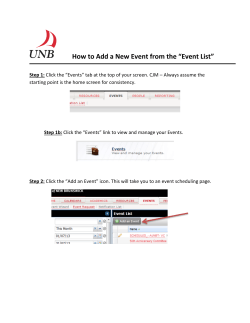
Intelligent Resource Scheduling for Reduced Turnaround Durations Rob Richards, Ph.D.
Intelligent Resource Scheduling for Reduced Turnaround Durations Rob Richards, Ph.D. Stottler Henke Associates, Inc. © 2010 Eventure Events. All rights reserved. Background & Perspective Stottler Henke • Artificial Intelligence Research & Development – Software Company • Video: Project Management Experience Resources and Critical Path (Resource Loaded) • Large organizations developing and building complex systems rely on schedules and project management. • Many CPPM projects are resource constrained (in reality, even if not modeled that way) • Resource constraints (e.g., labor, space, equipment) greatly complicates the scheduling problem. – Hence a ‘reason’ to ignore Where in the PM Space? • Project Management –… – Critical Path (Resource Constrained) • … • Scheduling / Level Resources • … –… Planning Model Tasks WBS Tasks Tasks Resource Definition Resource Pool Network Diagram Estimating Costs Duration Resources Network Initial Schedule Schedule Network Courtesy: Robin Nicklas. Phantom Float and the Resource Critical Path (PowerPoint slides). Personal communication, 29 May 2010. Allocate Resources Budget Leveled Schedule Cash Flow Baseline Copyright © 2010 Nicklas, Inc. All rights reserved. 5 Scheduling Background / Comparisons • Resource-Constrained Scheduling is NPComplete, takes exponential time for optimal solution – I.e., it is a hard problem – Approximate methods are needed • Most automatic scheduling systems use simple one-pass algorithms • Standard constraint-based approaches are far less computationally efficient (Aurora takes advantage of structure of scheduling problems and heuristics) Why Important? / Motivation • So much work is put into developing project plan before hitting the schedule / Level Resources … button Days, Weeks, Months • What if your resulting schedule is 10% longer than it needs to be because of the scheduling engine? • Would you care? How about 25+% longer? Motivation: Visual • Following figure shows. – Critical Path – Resource Constrained Critical Path (theoretically correct) • The goal is the shortest correct schedule Scheduling Engine Comparison Construction Examples (Kastor & Sirakoulis, 2009) Product 1st Example 2nd Example Duration Deviation from CPM (%) Duration Deviation from CPM (%) Primavera P6 709 52.8 308 29.41 MS Project 744 60.34 314 31.93 Open Workbench 863 85.99 832 249.58 Different Resource-Leveling Techniques • Deviation from Critical Path Duration Benefits of Sophisticated Underlying Scheduler • Results in a better initial schedule • Execution: Schedule is more flexible and better able to accommodate change. – Schedule is “self-aware” of what tasks can most easily be moved. I.e., tasks store information about what placed it where it is placed. – Quickly reschedule as if resources on late task are not available until after its estimated end time. Maybe Only for ‘Big’ Problems? • Let’s look at a toy problem … • ‘Simple’ problem with only 7 real tasks and 2 milestones. ‘Simple’ Network details • Number superscript of circle is duration in days • Number subscript of circle is resources needed • There is only 1 type of resource Critical Path of Network • Solution when infinite resources available – Find longest path = 1 + 1 + 5 = 7 • So Critical Path is 7 days Gantt Chart of Critical Path • Note: Sat/Sun are not workdays Set Resource Pool to 5 • Only one type of resource to make the problem ‘simple’ Gantt Chart Showing the Critical Path & Histogram • Note: now some resources are overloaded • Resource level to solve over allocation Resource-Leveled in MS Project = 9 days Resource Units Resource Units 5 1 2 6 3 4 7 Time Time Simple Enough, Right? • Another view of the solution But there is a better solution … P6 Model: Resource Leveled = 8 days Simple? • Critical Path = 1 + 1 + 5 =7 • 1 resource 5 total units End of Story… Not quite • There is an even better solution • 7 days • So this ‘simple’ problem could not even be solved well by the world’s ‘premier’ project management tools. • Can you solve this ‘simple’ problem in 7 days? Constraints Add Complexity • Technical constraints (E.g., F-S, F-F, S-F, lags) • Resource constraints – Labor constraints – Equipment, Tools (e.g., cranes) • Usage constraints – e.g., tool can only be used for so many hours continuously &/or during a day. • Spatial constraints – e.g., – job requires a certain location or type of space; – two elements should (or should not) be next to each other • Ergonomic constraints – individual limitations on work conditions Visualizing More Complex Situations • No good methods shown to date • Closest way is by similar problems – E.g., Tetris game, Tetris cube Tetris • Shapes similar to resource profile of individual tasks • Holes when playing Tetris represent resource allocation inefficiencies. – E.g., black regions in figure to the right • Try www.FreeTretris.org for yourself. Tetris Cube • More realistic to scheduling multiple types of resources per task is the Tetris Cube • If not pieced together properly then will not fit in box. • Video Refinery Turnaround Leveraging Intelligent Scheduling Technology Turnaround Project Network 2,500+ Tasks Results: 2,500+ Turnaround • Primavera P6 67.125 days – Performed by 3rd party • Aurora 56.27 days • Primavera P6 19.3% longer than Aurora • Critical Path is 46 days – P6 is 21.125 days longer than CP – Aurora is 10.27 days longer than CP – So % diff over CP is > 100% Long-Term Refinery-Related Upgrade MS Project 2007 = 1,627 days Primavera P6 = 1,528 days Primavera P3 = 1,258 days Intelligent scheduling (Aurora) = 1,240 days 300 Task Example: Aerospace Application Multiple Resource Types Needed for most tasks 300 Task Example: Network in Aurora Results: 300 Task Example • MS Project 2003 145.6 days • MS Project 2007 145.6 days • Primavera P6 115 days – Performed by 3rd party • Deltek Open Plan 110 days • Aurora 102.5 days Results • Multiple sources reveal the effect of the Scheduling Engine • For larger projects (>1,000): Aurora has been able to find project durations SIGNIFICANTLY shorter than other software for the same data set. • Much of the potential improvement offered by modeling resources is being squandered. • Resource leveled schedules are sub-optimal Planning & Execution • Initial Schedule benefits • Execution benefits even MORE – If scheduler is inefficient, every delay will be magnified because re-allocation of resources will be deficient Benefits of Sophisticated Underlying Scheduler • Results in a better initial schedule • Execution: Schedule is more flexible and better able to accommodate change. – Schedule is “self-aware” of what tasks can most easily be moved. I.e., tasks store information about what placed it where it is placed. Analogy: Chess • Chess mathematically is similar to resource loaded scheduling. – Easy: Create basic rules to play – Hard: Win against other intelligent players • Resource Leveling in most software is analogous to 'Easy' chess solution • Each move analogous to execution mode update, challenge continues throughout game/plan Take Aways • Scheduling engine is critical • Paying up to 100% penalty due to the scheduling engine • Changing to an improved scheduling engine is probably the greatest potential improvement available to your project – Just press a different button • Use more than 1 scheduling engine Rob Richards, Ph.D. Stottler Henke Associates, Inc. richards@stottlerhenke.com © 2010 Eventure Events. All rights reserved.
© Copyright 2025





















